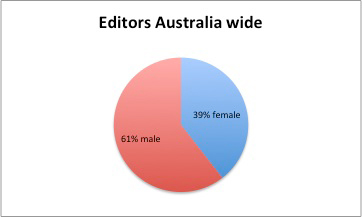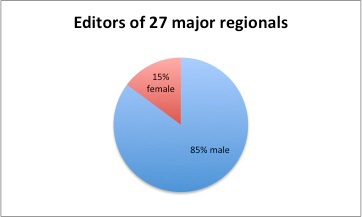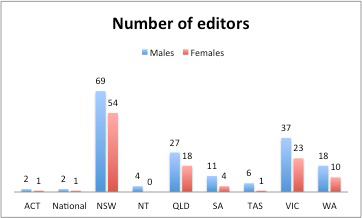Today on International Women's Day, we are launching New Matilda's investigation into women in the media.
There is no shortage of discussion about changes in the media and journalism but little about how women are faring in the media game. What say do women have in decisions? What voice do they have in stories? Is gender equity increasing? How are women represented in the daily media? Who produces and writes stories about women? How much is media tailored to meet advertisers' and marketers' gender needs? How does Australia compare with the rest of the world in media gender equity?
This series is about finding out some answers to these questions.
We begin in part one with a look at the impact on the top management of Australian media and the editorship of newspapers and their online sites. It is a snapshot of the top, particularly of the big mainstream companies, rather than an in-depth look at any one company. We used annual reports, websites, phone calls and the Newspaper Works Industry Yearbook for 2012 to collect our data. We have attempted to be as current as possible — but if you see something that is out of date or wrong, let us know.
In later parts of our project, we have a selected a date and coded the story content of publications across the media according to by-line, the gender of sources and their type, and the gender of images and their type. We will also look at the independent and alternative media — they claim to be different, but how different are they really? Do women play a different role?
This project is about starting a discussion. If the situation needs changing, how we can improve it? There is room for more people to get involved or devise their own projects.
Snapshot of the Top
Today, we are taking a snapshot of the top of the big mainstream companies which between them control hundreds of small rural and community newspapers. (We did not include the smaller independent media such as Private Media, which owns Crikey, and non-profits such as The Conversation. We will cover these in a separate report.)
Our research shows that men still dominate the top levels of the media. Only a few women can be found in the upper levels of the media. The public media are far more gender balanced than the private media.
Boards
Boards select CEOs and monitor the performance of companies. They agree on strategic direction and are responsible for overall fairness and accountability. Not all media companies have boards — some are private companies. We identified boards for Nine Entertainment Co., Seven West Media, Channel 10, Fairfax Media, News Corporation, APN, Foxtel, Southern Cross Austereo, Macquarie Radio Network, ABC and SBS. (We did not include Telstra which includes the Telstra Media group but is not predominantly a media group. The Chair of Telstra is a woman.)
We identified 95 board members. Of these 74 are men. There are only 21 women. 22 per cent of board members are women.
Remove the two public broadcasters ABC and SBS and the picture from a gender perspective looks grim. The ABC has eight board members of which four are women. SBS has nine of which five are women. SBS is the only media organisation we identified that has a board with a majority of women.
Without the ABC and SBS, 66 of the remaining 78 board members are men — only 15 per cent of board members in private media companies are women. Some have no women at all.
According to their website, Nine and the provincial publisher APN have no women on their boards. Seven West Media (which owns Channel 7 and dominates the media in Western Australia), Foxtel and Southern Cross Austereo have nine members on their boards, of which only one is a woman.
Channel Ten do best with only three out of 10, one of whom is Gina Rinehart.
Of the two big print/digital companies, Fairfax Media has only two women on their nine member board and News Corporation has two women on its 16 member board.
Who's In The Chair?
We identified 15 chairpersons of big media organisations. They include Lachlan Murdoch who chairs his own radio company DMG as well as being a director of Ten and on the board of News Corp, Ross McPherson who is Chair of the McPherson Media Group (which owns rural papers in Shepparton) and Aegis Media which is the company of one of Australia's most powerful communication figures, Harold Mitchell. We could only identify one woman who is chair of a mainstream Australian media organisation.
Yvonne Bauer is Chair of Bauer Media, a private family company, which recently brought ACP magazines. Previously the company had been owned by the family of James Packer. She is based in Germany.
Both the ABC and SBS Boards are headed by men — Jim Spigelman and Joseph Skrzynski.
CEOs
Chief executives are responsible to the board and make key day to day decisions. They are hired by boards and exercise power over the choice of executives down the line.
We identified 24 CEOs of which 23 are men. The single woman we could identify is Deborah Wright, who heads regional based broadcaster NBN, which is closely associated with Channel Nine.
This means less than 4 per cent of CEOs of big mainstream media companies are women. Both the ABC (Mark Scott) and SBS (Michael Ebeid) have male CEOs. It's unlikely that this figure will increase in the near future — If and when these CEO positions become vacant. (This list of CEOs is not complete so If you know of any other women CEOs please contact us.)
Executive Teams
We looked at the executive teams of 12 media organisation and, using their websites, identified 109 people in their executive teams. Of these only 19 — or 17 per cent — were women. The ABC was best with six of 10 in its executive team. Channel Nine has no women on its board or in its top executive team. Channel Seven has no women on its executive team of 10 and only one on its board.
Channel Ten has two women on its nine member team, one of whom, Rebekah Horne, is responsible for Ten's media strategy.
Fairfax Media has 13 people on its executive team, which includes only two women. One of these, Gail Hambley, is the legal counsel and the other, Michelle Williams, heads human resources. While these are important roles they have little connection with editorial decision-making and shaping Fairfax content.
Our analysis does not include all companies and there are more women involved in management further down the line. Nonetheless, it shows that women are grossly under-represented in the upper echelons of Australian media management, particularly in the private media.
In the rest of today's report we will focus on newspapers and their increasingly important and well used online sites. In further reports, we will include more data on television, radio and other online media.
Editors
Day to day decisions about content are made by editors. We identified the editors of 418 newspapers (nearly all of which have online sites), including national, metro, suburban, regional, rural and a selection of specialist papers. This represents a strong sample of newspapers Australia wide.
- 140 of these papers are edited by women, that is 33.5 per cent.
- 278 of these papers are edited by men, that is 66.5 per cent.
Approximately one-third of Australian newspapers in the group examined are edited by women. However, many of those edited by women are small community and rural newspapers which are owned and take much of their content from the bigger mastheads. Further, as companies cut costs, some editors of small papers edit two or more papers. Where we identified this we counted them as separate papers.
Across these 418 titles, there are 294 editors: 116 women (39 per cent) and 178 men (61 per cent).
 |
But at the top, the story is far less balanced — in fact in the upper echelons of the mainstream editors, women all but disappear.
Of 16 major national and metro papers we looked at, there was only one female editor: Michelle Gunn, who edits The Australian's Weekend edition. Judith Whelan edits the Saturday edition of the Sydney Morning Herald but this is not a separate masthead. There are also female editors of editions of MX, the free commuter newspaper produced by News Ltd.
The line between what is identified as a regional, provincial or rural paper can vary. We identified 27 larger regional papers including the Illawarra Mercury, Newcastle Herald, Northern Star, Warrnambool Standard, Bendigo Advertiser, Gold Coast Bulletin, Townsville Bulletin, Cairns Post and others. We found only four of these were edited by women. These editors are Carmel Puckett at Kalgoorlie Miner, Di Thomas at Border Mail, Kristin Favaloro at Shepparton News and Liz Tickner at Maitland Mercury. The rest were edited by men.
 |
When it comes to deciding the shape of our newspaper and online media, Australian mainstream print/online media is extremely male-dominated.
There are of course many female editors in the middle ranks of big publications but even here men dominate. However our research confirms earlier research by Louise North which found that Australia performs well below the global average in women's participation in media management. (More background about this and links to other relevant research by North and others can be found on the Australian Centre for Independent blog.)
By State and Territory
Australian national — The Australian and the The Australian Financial Review
- Two men
- One woman — Weekend Australian
ACT
- One woman
- Two men
NSW
- 54 women
- 69 men
NT
- Four men
QLD
- 18 women
- 27 men
SA
- Four women
- 11 men
TAS
- One woman
- Six men
VIC
- 23 women
- 37 men
WA
- 10 women
- 18 men
Male dominance appears to be most severe in Tasmania (84.6 per cent), South Australia (82.1 per cent), Western Australia (73.9 per cent) and Queensland (72.9 per cent). NSW comes closest to gender equity with 58.2 per cent men and 41.8 per cent women.
We will post the database of current editors on the web at the end of the project. We can report that it is much easier to find out about advertising on Fairfax Media and News Ltd's small newspapers than it is to find information about their editors.
 |
We will look more closely at the independent media in another report. As Jenna Price notes today, the independents seem to be developing a way that is more balanced. Of nine sites we looked at (Guardian AU, The Hoopla, Mamamia, New Matilda, The Global Mail, The Monthly, Crikey, Mumbrella and The Conversation), we found women came out slightly ahead, with five women in editorial roles, compared to four men.
Conclusion
International Women's Day is just one day. Eighteen years ago, there was a whole year — International Women's Year 1975. During that year, while women were attending a feminist conference in Canberra, the Canberra Times published a sexist editorial. The response was an occupation of their offices. The result was that the Canberra Times was handed over to a feminist editor for a day.
It was not until 1993 that Michelle Grattan was appointed editor of the Canberra Times, the first woman to edit a major daily in Australia. After two years, she was removed and she returned to the her political editor role at The Age until she moved a few weeks ago to The Conversation. Today no woman edits a major daily.
Feminist activism and publishing is back and there's no doubt it is needed. There's Destroy the Joint, blogs like News With Nipples, The Hoopla and Anne Summers' new online magazine.
Christine Holgate is one of three women on the board of Channel Ten and the CEO and managing director of Blackmores. She's from the UK and was involved media in the UK. She was asked at a UTS seminar on women and leadership this week about how women get on boards:
"My observation when I came to Australia was 'Wow! It's so blokey here!' You know, there literally were no women and when I got to Channel 10 I felt, at first, I was the token woman to join the board. "For actually a long while I questioned the then chairman, 'Was that the case?' — because I wouldn't take it otherwise. But then part of me said, 'You know there's lots of women in that organisation, [the employees]are women but there was nobody in the senior ranks, or nobody on the board previously'. "So I thought 'I'm going to get there and fight for the rights of women', and so we do now have a diversity policy among the remuneration committee, fighting for fair pay. I've fought for the transparency of labour turnover for women, and actually for fair pay for men by the way. And we have our first female executive member … who runs programming, so that's a breakthrough."
It's time to start talking loudly about media and gender. Our first step is to ask the large companies about their plans for gender equity.
Our second report will be a snapshot of the editorial content of one day's print/online media. There will be further reports on television, radio, magazines and independent and alternative media. Our Twitter hashtag for the project is #OzMediaWomen. Join the discussion.